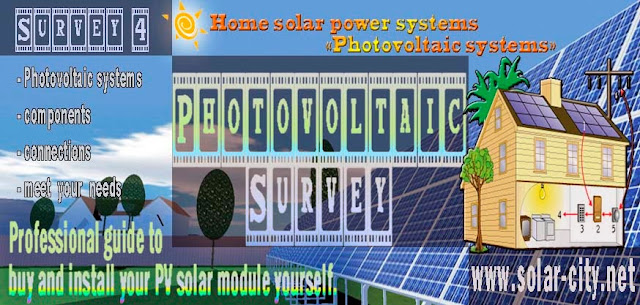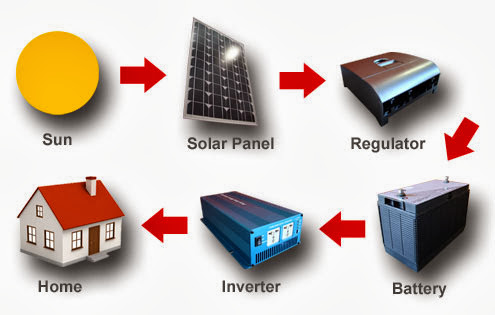Home solar power systems - Photovoltaic systems
Home solar power systems :
When we hear the phrase "Home solar power systems", all the applications which convert solar power to a useful power for our homes come in our imagination.
These applications could be "photovoltaic systems", "Solar water heaters", "solar cooker" and more...
But as we used in our homes, electricity can run everything. So most of us think about "photovoltaic systems" the first thing and we are going to cover "Photovoltaic systems" in this topic.
These applications could be "photovoltaic systems", "Solar water heaters", "solar cooker" and more...
But as we used in our homes, electricity can run everything. So most of us think about "photovoltaic systems" the first thing and we are going to cover "Photovoltaic systems" in this topic.
Consumption:
When you decide going solar the first thing you'll need to know is your electric consumption and how much money you could save monthly if you used photovoltaic systems. You can read this topic "Average Electric Power Consumption" to know more.
Cost:
Before deciding to spend thousands of dollars on a Photovoltaic system, It’s wise to evaluate how energy-efficient your home is, and how much your family’s lifestyle affects your energy usage. Without knowing this information, you really can’t determine the size of the Photovoltaic system that’s right for your home. You can read this topic "Size & Cost of photovoltaic system you'll need to cover your electrical consumption"
Photovoltaic systems:
Solar Photovoltaic systems are technologies that convert the energy from sunlight into electrical energy. Residential solar Photovoltaic systems can offset much of your household's power needs, depending on the size of the system, your household's needs and your location.
Photovoltaic systems components:
All of these kinds only could generate DC electrical power.
You can see more about photovoltaic (PV) effect, how do photovoltaic (PV) cells work, photovoltaic panels, Types of PV panels and Which type is more suitable with you. By visiting previous topic "What is photovoltaic effect, definitation and types of PV solar panels?"
2. Mounting frame:
Mounting frame is the frame where we mount our solar modules or panels, But what is the importance of it? - OK
In fact it's very important to know exactly the most efficient position and adjusting it's angel according to your location on the earth in order to collect the most amount of sunlight you can.
This topic could help you "Solar systems installation"
Photovoltaic
panel or module is a combination of solar cells which is connected
together in series or in parallel and collected in one frame - See more
at:
http://www.solar-city.net/2013/10/what-is-photovoltaic-effect_7.html#sthash.dZfSNUIY.dpuf
3. Charge controller:
It plays a vital role in regulating the voltage that enters the batteries in order not to cause failure.
4. Battery:
Batteries are the best method of storing energy from Photovoltaic systems for the periods when the sun is not shining. (This is for stand-alone or non -grid connected systems.)
Most of Batteries used in Photovoltaic systems generates typically 12 volts and their capacities are measured by the unit (amp.hours)
Deep cycle batteriesare available for golf carts, and include Industrial Chloride batteries. These batteries are the best choice for Photovoltaic systems as they can be discharged 80%. The golf cart batteries will last 3-5 years. There are some larger capacity deep cycle batteries that will last 7-10 years. Industrial Chloride batteries will last 15-20 years.
5. Inverter:
All applications and equipments in our homes uses Alternating current (AC) power, but solar panels generate Direct current (DC) also batteries store DC power. So inverters are used in photovoltaic systems in order to convert DC into AC and they are reliable and efficient. An inverter has a major cost of the photovoltaic system. It could start with 1000$.
It plays a vital role in regulating the voltage that enters the batteries in order not to cause failure.
4. Battery:
Batteries are the best method of storing energy from Photovoltaic systems for the periods when the sun is not shining. (This is for stand-alone or non -grid connected systems.)
Most of Batteries used in Photovoltaic systems generates typically 12 volts and their capacities are measured by the unit (amp.hours)
Deep cycle batteriesare available for golf carts, and include Industrial Chloride batteries. These batteries are the best choice for Photovoltaic systems as they can be discharged 80%. The golf cart batteries will last 3-5 years. There are some larger capacity deep cycle batteries that will last 7-10 years. Industrial Chloride batteries will last 15-20 years.
5. Inverter:
All applications and equipments in our homes uses Alternating current (AC) power, but solar panels generate Direct current (DC) also batteries store DC power. So inverters are used in photovoltaic systems in order to convert DC into AC and they are reliable and efficient. An inverter has a major cost of the photovoltaic system. It could start with 1000$.
Photovoltaic systems connection types:
Photovoltaic systems are generally classified
according to their function and operational requirements and how the system is connected to other
power sources and electrical loads. The two main types
are "grid-connected or utility-interactive systems" and "stand-alone
systems". Photovoltaic systems can be designed to provide DC and/or AC
power service, can operate interconnected with or independent of the
utility grid, and can be connected with other energy sources and
energy storage systems.
Stand alone photovoltaic systems:
Stand-alone photovoltaic systems are designed to operate independent of the
electric utility grid, and are generally designed and sized to supply
certain DC and/or AC electrical loads. These types of systems may be
powered by a photovoltaic module only or wind energy or an engine-generator as an auxiliary power source in what is called a
"PV-hybrid" system.
These photovoltaic systems requires batteries to store power for the times when the sun is not shining.
Stand alone system or separate system can exist in a home that also has grid utility power as long as they are completely separated.
These photovoltaic systems requires batteries to store power for the times when the sun is not shining.
Stand alone system or separate system can exist in a home that also has grid utility power as long as they are completely separated.
Grid connected "grid interface" photovoltaic systems:
Grid interface photovoltaic systems are designed to operate in parallel with and interconnected with the electric utility grid.
The primary component in grid-connected photovoltaic systems is the inverter, or power conditioning unit (PCU). The PCU converts the DC power produced by the photovoltaic array into AC power suitable for the voltage and power quality requirements of the utility grid, and automatically stops supplying power to the grid when the utility grid is not energized.
A bi-directional interface is made between the photovoltaic system AC output circuits and the electric utility grid, typically at an on-site distribution panel or service entrance. This allows the AC power produced by the photovoltaic system to either supply home electrical loads, or to back-feed the grid when the photovoltaic system output is greater than the home load demand. At night and during other periods when the electrical loads are greater than the photovoltaic systems output, the balance of power required by the loads is received from the electric utility This safety feature is required in all grid-connected photovoltaic systems, and ensures that the photovoltaic systems will not continue to operate and feed back into the utility grid when the grid is down for service or repair.
The primary component in grid-connected photovoltaic systems is the inverter, or power conditioning unit (PCU). The PCU converts the DC power produced by the photovoltaic array into AC power suitable for the voltage and power quality requirements of the utility grid, and automatically stops supplying power to the grid when the utility grid is not energized.
A bi-directional interface is made between the photovoltaic system AC output circuits and the electric utility grid, typically at an on-site distribution panel or service entrance. This allows the AC power produced by the photovoltaic system to either supply home electrical loads, or to back-feed the grid when the photovoltaic system output is greater than the home load demand. At night and during other periods when the electrical loads are greater than the photovoltaic systems output, the balance of power required by the loads is received from the electric utility This safety feature is required in all grid-connected photovoltaic systems, and ensures that the photovoltaic systems will not continue to operate and feed back into the utility grid when the grid is down for service or repair.
Lifespan and maintenance:
Solar Electric systems last a long time depending on the amount of
active use, or the amount of sunshine converted into electricity by the photovoltaic modules .
Manufacturers will usually provide 20+ year warranty, but photovoltaic modules
will likely last longer than that. The balance of system components,
however, will have a shorter life.
Without any moving parts, maintaining photovoltaic systems is relatively simple.
For grid-connected systems, minimal maintenance is required, including keeping the panels free of any dirties such as fallen leaves, bird droppings, etc.
For stand-alone systems, the batteries usually require the most
maintenance.Without any moving parts, maintaining photovoltaic systems is relatively simple.
For grid-connected systems, minimal maintenance is required, including keeping the panels free of any dirties such as fallen leaves, bird droppings, etc.
Photovoltaic systems manufacturers will usually provide a 20+ year warranty on the Photovoltaic modules, and a 10-year warranty on the balance of system components.
Before deciding to spend thousands of dollars on a Photovoltaic system, It’s wise to evaluate how energy-efficient your home is, and how much your family’s lifestyle affects your energy usage. Without knowing this information, you really can’t determine the size of the Photovoltaic system that’s right for your home. - See more at: http://www.solar-city.net/2013/09/size-of-pv-panels-you-need-to-cover.html#sthash.487S6lQj.dpuf
















It seems like some of the written text within your posts are running off the screen.
ReplyDeleteFinally I have found something which helped me. Appreciate it!
ReplyDeletesolar photovoltaic systems
There are many benefits, advantages and opportunities in residential solar. We can benefit from it and at the same time we can make money too by selling it.
ReplyDeleteMake Money Selling Residential Solar from Home